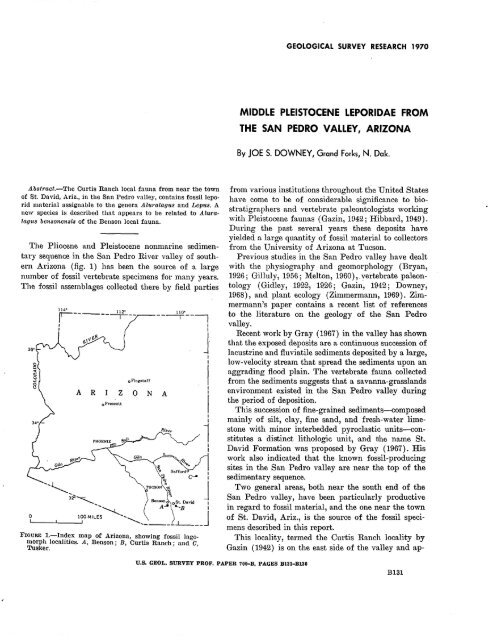RESEARCH· ·1970·
RESEARCH· ·1970·
RESEARCH· ·1970·
Create successful ePaper yourself
Turn your PDF publications into a flip-book with our unique Google optimized e-Paper software.
A.bstmct.-'l'he Curtis Ranch local fauna from near the town<br />
of St. David, Ariz., in the San Pedro valley, contains fossilleporid<br />
mnterinl ussignnl.>le to the genera A.lm·alag1t8 and Lepus. A<br />
new species is described that appears to be related to A.Zurala.g1t·8<br />
bensoncnsis of the Denson local fauna.<br />
The Pliocene a.nd Pleistocene nonmarine sedimentary<br />
sequence in the San Pedro River valley of southern<br />
Arizona (fig. 1) has been the source of a large<br />
number of fossil vertebrate specimens for Inany years.<br />
The fossil assemblages collected there by field parties<br />
v-------------r---<br />
----r-----,<br />
114' 112' 110'<br />
1<br />
I<br />
A<br />
R<br />
0 Prescott<br />
Z 0<br />
oFingstaff<br />
N A<br />
1l'IOURE 1.-Index map of Arizona, showing fossil lagomorph<br />
localities. 11, Benson; B, Curtis Ranch; and o,<br />
Tusker.<br />
GE,OLOGICAL SURVEY RESEARCH 1970<br />
MIDDLE PLEISTOCENE LEPORIDAE FROM<br />
THE SAN PEDRO VALLEY, ARIZONA<br />
By JOE S. DOWNEY, Grand Forks, N. Dak.<br />
from various institutions throughout tli.e United States<br />
have come to be of considerable significance to biostratigraphers<br />
and vertebrate paleontologists working<br />
with Pleistocene faunas ( Gazin, 1942; Hibbard, 1949).<br />
During the past several years these deposits have<br />
yielded a large quantity of fossil material to collectors<br />
from the University of Arizona at Tucson.<br />
Previous studies in the San Pedro valley have dealt<br />
with the physiography and geomorphology (Bryan,<br />
1926; Gilluly, 1956; :Melton, 1960),.yertebrate paleontology<br />
(Gidley, 1922; 19.26; Gazin, 1942; Downey,<br />
1968) , and plant ecology (Zimmermann, 1969) . Zimmermann's<br />
paper contains a recent list of references<br />
to the literature on the geology of the San Pedro<br />
I valley.<br />
Recent work by Gray (1967) in the valley has shown<br />
j that the exposed deposits are a continuous succession of<br />
lacustrine and fluviatile sediments deposited by a large,<br />
I<br />
I low-velocity stream that spread the sediments upon an<br />
aggrading flood plain. The vertebrate fauna collected<br />
I from the sediments suggests that a savanna-grasslands<br />
I<br />
environment existed in the San Pedro valley during<br />
the period of deposition.<br />
I This succession of fine-grained sediments--composed<br />
I<br />
I mainly of silt, clay, fine sand, and fresh-water limestone<br />
with minor interbedded pyroclastic units-constitutes<br />
a distinct lithologic unit, ·and the na.me St.<br />
l<br />
I<br />
I David Formation was proposed by Gray (1967). His<br />
work also indicated that the known fossil-producing<br />
sites in the San Pedro valley are near the top of the<br />
sedimentary sequence.<br />
Two general areas, both near the south end of the<br />
San Pedro valley, have been particularly productive<br />
in regard to fossil material, and the one near the town<br />
of St. David, Ariz., is the source of the fossil specimens<br />
described in this report.<br />
This locality, termed the Curtis Ranch locality by<br />
Gazin (1942) is on the east side of the valley and ap-<br />
U.S. GEOL. SURVEY PROF. PAPER 70D-B, PAGES B131-Bl36<br />
Bl31
















